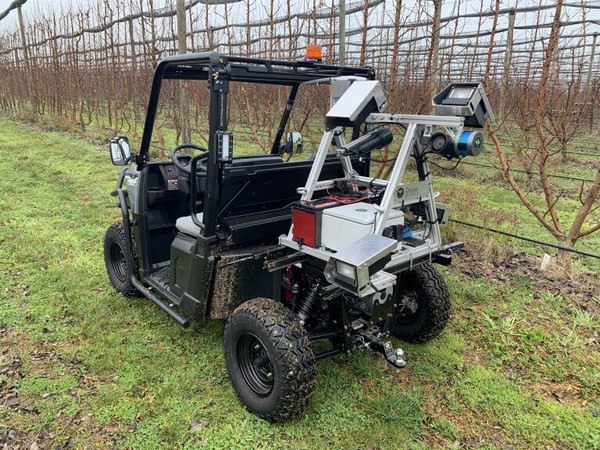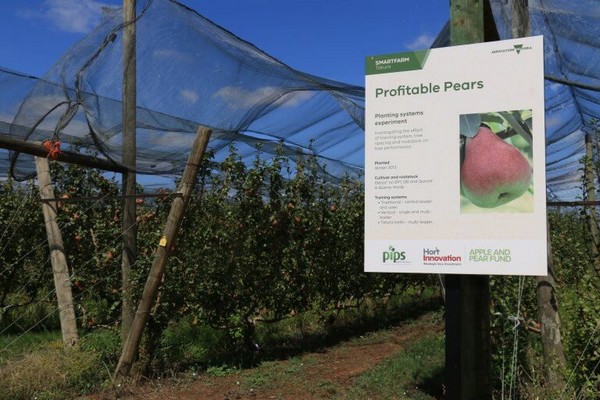Experimental pear blocks at Agriculture Victoria’s Tatura SmartFarm will provide insights into the effects of rootstock, training systems and tree density on fruit yield and quality.
Would you like to know how many pears you are growing before harvest? Would you like to know how many pears you should be growing to get the best packout and fruit quality? Would you like to know how effective different thinning strategies are for pears? Do you need to improve red colour development in blush pears without increasing the risk of sunburn?
If you answered yes to the above questions, then watch this space. The new Developing smarter and sustainable pear orchards to maximise fruit quality, yield and labour efficiency project – one of four in the recently-announced third round of the levy-funded Productivity, Irrigation, Pests and Soils program (PIPS3) – aims to provide tools to help answer these questions. Agriculture Victoria is collaborating with the Tasmanian Institute of Agriculture (TIA), Green Atlas and SwarmFarm Robotics to develop climate-smart pear orchard systems and to provide the knowledge and tools to consistently produce better quality pears.
The experimental pear blocks at Agriculture Victoria’s Tatura SmartFarm will be used to continue to provide comparisons of rootstock, training system and tree density effects on yield and fruit quality. The recent Profitable Pears project (AP12002), identified that yields of young trees were compromised when pears were grown on BP1 rootstock (compared to trees on Quince A with Beurre Hardy interstem or D6) and that, while yields increased with increasing tree density to 2222 trees/ha, there was no yield benefit in further increasing tree density to 4444 trees/ha.
Crop load targets
At fifth leaf, there were indications that Open Tatura trellis training systems could deliver better size fruit when fruit numbers were high than vertical hedgerow (2-D) or traditional 3-D training systems. Now that the trees are reaching maturity, relationships between fruit number and fruit size and quality will be analysed to determine target crop loads to maximise pack-out yield.
Dr Sally Bound (TIA) will apply crop regulation treatments to ANP-0131 (marketed as Rico®) at the Tatura SmartFarm. Sally is looking forward to applying her knowledge of thinning in apples and older pear cultivars to the new generation of pear cultivars in high density orchards.
“I am confident that we will be able to implement a successful thinning program,” Sally said. “We have a wide range of options to examine, including some of the newer thinning chemicals now available, mechanical thinning, and also looking at pruning and artificial bud extinction options.”
Mobile sensing platforms developed by SwarmFarm Robotics and Green Atlas will be used in Agriculture Victoria’s SmartFarm during the next two seasons to evaluate if methods for detection of apple flowers and fruit can be applied to pear orchards. SwarmFarm Robotics’ Will McCarthy is keen to discover if image analysis can be used to not only map flower clusters in an orchard, but also identify phenological stage of pears.
“We found during our previous work that growers wanted to apply thinners at particular phenological stages, but they lack the technology to assess the stage of the whole block on a tree-to-tree level,” explained Will.
“In apples, we are developing a system that can map the growth stages of apple trees and give a snapshot of what is happening in the orchard at an individual tree level. This information can be utilised for thinning management decisions. So far the technology looks very promising and we are excited to continue to develop it for the industry.”

Agriculture Victoria has bought a Cartographer™ – a smart tech device that combines technology and software to allow quick and accurate flower and root count mapping – from Green Atlas and it will be used in several pome and stone fruit projects. It is equipped with optical cameras, LiDAR and GPS to map the variation in fruit, nut and flower number across an orchard. A neat dashboard displays maps of the variation in fruit number across an orchard within a few hours. The technology is being commercially used by the apple and almond industries.
Green Atlas co-founder Steve Scheding said the company was excited at the prospect of demonstrating and further developing its mature commercial Cartographer platform for the benefit of the Australian pear industry.
“With over 30,000 hectares of tree crops already scanned worldwide, pears are a great match for our capabilities,” Steve said.
In the SmartFarm pear orchard we will not only test the detection of pears in an orchard but also test the ability to measure fruit size and colour, and tree canopy size. Following initial testing and calibration, commercial orchard sites will be sought to further evaluate the performance of the Cartographer.
Studies by Agriculture Victoria have established that light exposure is a requirement for red colour development in the blush pear selections that came out of the Australian National Pear Breeding Program (e.g. ANP-0534, ANP-0131 and ANP-0118 – the latter two marketed as Rico® and Lanya®). Novel strategies will be investigated in commercial orchards in 2021–22 to attempt to enhance red colour of blush pears without increasing sunburn risk. At the same time, the role of temperature in colour bleaching will be examined.

Experimental pear blocks at the Tatura Smart Farm
This project is part of the apple and pear industry’s PIPS3 (Productivity, Irrigation, Pests and Soils) program of research and development. The project is funded by Hort Innovation, using the Hort Innovation Apple and Pear research and development levy, contributions from the Australian Government and co-investment from Agriculture Victoria. Hort Innovation is the grower-owned, not-for-profit research and development corporation for Australian horticulture.
